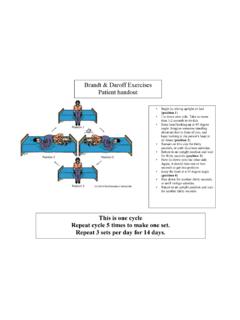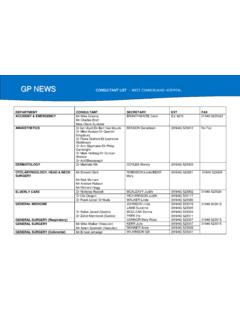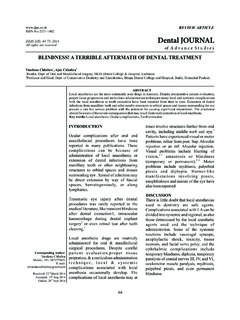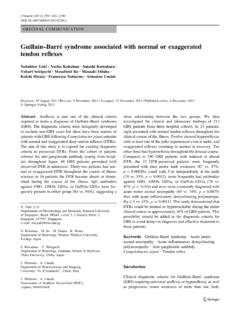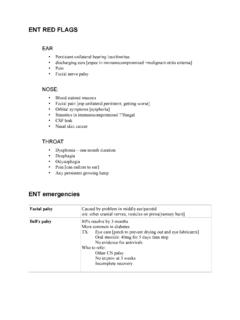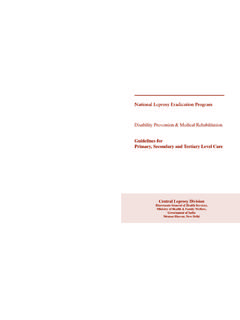Transcription of Management and referral guidelines for ENT in …
1 Management and referral Management and referral guidelines for ENTguidelines for ENTin Primary Carein Primary CareNorth Cumbria University Hospitals TrustContentsContentsChronic rhinosinusitisGlobus pharyngeusHoarsenessDizzinessHearing lossSnoring / Sleep apnoeaOtitis externaChronic catarrhRed flagsDiagnostic criteriaChronic RhinosinusitisChronic RhinosinusitisUnilateral blockageUnilateral dischargeBloodstained dischargeCrustingEye symptoms/signsFocal facial swelling esp in elderly smokers woodworkers2 or more symptoms, 1 of which must be hard ;Hard symptomsSoft symptomsNasal block/congestion Loss of smellNasal dischargeFacial Facial pain in absence of nasal symptoms is notsuggestive of = <12 wks; complete resolutionCHRONIC = >12 wks; incomplete resolutionDiagnosis is confirmed by; Endoscopic signs (oedema, pus or polyps)and/or CT findings (mucosal disease)Primary Care managementWhen to referIf no polyps evident;Salinenasal douche/sprayIntranasal steroidspray for 3/12 antihistamine(if allergy) if no response add oral macrolidefor 3/12If polyps evident.
2 Mild symptoms = steroid sprayfor 3/12 Moderate symps = steroid dropsfor 3/12 Severe symps = steroid tabletsfor 1 week Any red flags No response to medical therapy as across If pt willing to consider surgeryNB Consider allergy tests in parallel with referral Plain XR films notused for either acute or chronic rhinosinusitis nor for facial based guidelines available in summary form at flagsDiagnostic criteriaGlobus PharyngeusGlobus PharyngeusPain (throat or ear)DysphagiaPersistent hoarsenessLateralising symptoms Clinical diagnosis based on history Feeling of something in the throat; tickle/hair lump constriction Often exacerbated by stress Usually in non=smokers May have reflux symptomsPrimary Care managementWhen to referReassurance is keyAddress life issuesDiscourage throat clearing ice water sipsIf reflux symptoms.
3 Raise end of bed Consider proton pump inhibitor+ Gaviscon Advance 3/12 Any red flagsPersistent symptoms > 3/12 Need for further reassurance but stress to pt when this is the intention rather than for further investigationNB globus sensation alone does not require 2WW flagsDiagnostic criteriaHoarsenessHoarsenessPersistent hoarseness > 3 weeksPainDysphagiaHaemoptysisOtalgiaNeck lumpEspecially in = smokers= over 40yrs Persistent hoarseness more suggestive of pathology than intermittent hoarseness. Enquire about voice use/abuse= Public speaking= Amateur dramatics= Karaoke= Pitch=side coaching ? Reflux symptomsPrimary Care managementWhen to refer Lifestyle measures control voice abuse/overuse Stop smoking Review inhaler use rinsing Consider effects from occupation teacher, lecturer, singer.
4 Call centre operator Red flags Intermittent hoarseness >12 weeks and not responding to lifestyle measures acrossRed flags through 2WW path or urgent C&BRed flagsDiagnostic criteriaDizzinessDizzinessOtalgiaEar dischargeHeadacheVERTIGO = perception of room spinningv sIMBALANCE = light=headedness/drunk/fuzzinessGenerall y unlikely to be vestibular pathology if no suggestive when otological cause onset, duration, frequency recurrent vertigo for secs/mins = BPPV recurrent vertigo for hours = Menieres persistent vertigo for days = labyrinthitis / neuronitisInquire about associated ear symps eg HL / tinnitusOtoscopy + tuning for tests?
5 Nystagmus present during symptomatic s rather than Romberg s for vestibular patholDix=Hallpike test for BPPVP rimary Care managementWhen to referLifestyle measures caution with driving/activitiesTrying stopping meds before starting new -Epley manoeuvre 80% success rateMeniere s disease(actually quite rare);= reduce salt, chocolate, red wine= bendrofluazide Betahistine 8=16mg tds (prophylaxis)Labyrinthitis/neuronitis= self=limiting but often recurs with decreasing frequency/intensity. Symptomatic treatment only but:No longterm vestibular sedatives cinnarizine or prochlorperazine these dampen the compensatory mechanisms and prolong symptoms in the recovery phase.
6 Red flags For Epley if practitioner unfamiliar Meniere s unresponsive to trial of betahistineLay information available at flagsDiagnostic criteriaHearing lossHearing lossUnilateral loss with no past ear surgerySudden onset hearing lossOther cranial nerve signsEnsure ears free of waxOtoscopyFree=field speech: ask to repeat series of numbers/letters/words whilst standing behind and rubbing tragus of non=test ear. >50% correct is fork tests:SNHL: AC better than BC (Rinne +ve)Weber away from bad earCHL: AC worse than BC (Rinne ve)Weber towards bad ear(AC= air conduction, BC= bone conduction)Primary Care managementWhen to referLifestyle tips & aids: face to face conversations telephone amplifier doorbell amplifierRefer to ENT if.
7 Unilateral symptoms associated ear symptoms (other than tinnitus) abnormal tympanic membraneIf >60yrs with bilateral hearing loss and no ear pathology/abnormality, refer directly to referral criteriaRed flagsDiagnostic criteriaSnoring / sleep apnoeaSnoring / sleep apnoeaDaytime somnolesenceWitnessed apnoeasApnoea = breath=holding episode lasting >10 seconds terminated by a Sleepiness Score assesses symptoms of daytime <10 makes OSA unlikely even if witnessed with OSA tend to be hyperactive during the day rather than Care managementWhen to referActive weight lossStop smokingAvoid alcohol 4 hours before bedReview sedative prescriptionTreat rhinitisSuggest trial of mandibular advancement device SnorebanAll of above need attention prior to referral for sleep
8 Studies / snoring surgeryPatient s responsibility to inform DVLA when OSA responsibility to inform DVLA if untreated OSA pt is witnessed sleep apnoeaSnoring refractory to above conservative measuresPatient willing to be considered for (painful) snoring surgeryBMI <29/30 General lay information available at flagsDiagnostic criteriaOtitis externaOtitis externaPainless dischargePain out of keeping with findingsProtracted otalgia (esp in diabetic)Recurrent/persistent unilateral infectionCranial nerve weaknessPain/itch + dischargeIf one without the other, unlikely to be simple OEMastoid tenderness in adults is more often OE than true OE = severe, deep boring pain+ granulations in canal+/= cranial nerve palsyin diabetic patientPrimary Care managementWhen to referImmediate Ear swab for microbiology Dry mop conchal bowl/distal canal Treatment is topical with drops/spray If pinna involved.
9 Oral ab s can be addedLongterm/prophylaxis consider underlying skin condition close diabetic control water precautions review shampoo Earcalm spray (acetic acid) regularlyTopical ab s OK to use with perforation if infection present and only used short term (<10days)Any red flagsSuspected cholesteotoma abnormal attic, painless dischargeProtracted symptoms resistant to topical therapyCellulitis spreading onto faceInfections interfering with hearing aid useRed flagsDiagnostic criteriaChronic catarrhChronic catarrhBlood stained dischargeUnilateral dischargeDelineate if true discharge presentOften cluster of classical symptoms.
10 = phlegm gathering in throat= postnasal drip= choking sensation= ineffective nose blowing= nasal congestionCommonly proceeded by a coldInvariably non=smokersUsually symptomatic for yearsPrimary Care managementWhen to referOnly for reassurance/closure= and explain that this is the caseInvestigations rarely indicated nor fruitful in chronic that this is a common but difficult condition to treat. Current belief is that it is a sensory coping nasal irrigation Sterimar, NeilmedMay try intranasal steroid but expect little benefit.
